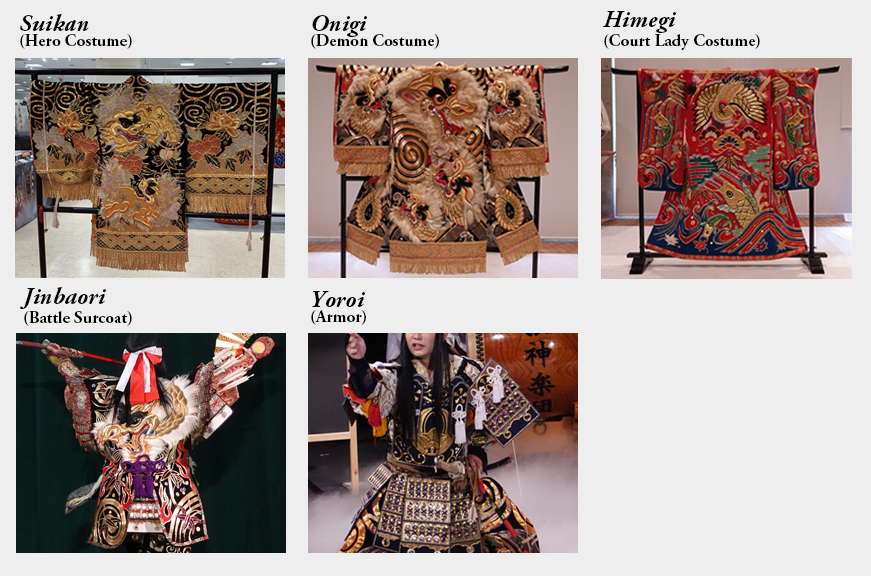Geihoku Kagura: The Star of Hiroshima Kagura
Geihoku Kagura is the musical entertainment show of Japanese traditional performing arts. Passed down in the mountainous regions of northern Hiroshima Prefecture, Geihoku Kagura’s roots are in Iwami Kagura, which came to the region via Shimane Prefecture in the Edo period. Since then, the artform has evolved and developed into a unique form of kagura that is carefully passed down to this day.
It is the most active form of kagura in Hiroshima Prefecture today with approximately 150 troupes carrying on its legacy. A note about kagura troupes: each troupe is composed of local community members who are not performers by trade. Members gather after school or work to practice the art of kagura and ensure it is preserved across generations. In turn, the practice of kagura helps to foster faith in Shinto shrines, carrying on their ancestor’s spirit of reverence and gratitude to nature and the gods.
But kagura is more than just a ritual: it’s a beloved artform with easy-to-understand stories, elaborate costumes, dynamic movements, and standout performances. Below you’ll find some ways to make your experience of Geihoku Kagura even better!
Viewing Etiquette
Kagura might be a religious ritual, but it’s not meant to be enjoyed silently. At performances, you’ll hear thunderous applause and cheers from the audience during scenes where beautiful court ladies turn into fearsome demons, when the main bad guy comes out on stage, and during the fierce battle scenes. The audience is just as much a part of the performance as the performers on stage, so be sure to let them know you’re watching and give them a big round of applause! Geihoku Kagura has so much to offer audiences, from emotional stories to relatable characters, live music, and more!
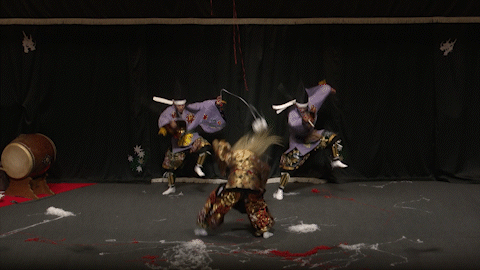
Katagiri (quick costume changes) are one of the highlights of kagura
Kagura Plays
Kagura might be a religious ritual, but it’s not meant to be enjoyed silently. At performances, you’ll hear thunderous applause and cheers from the audience during scenes where beautiful court ladies turn into fearsome demons, when the main bad guy comes out on stage, and during the fierce battle scenes. The audience is just as much a part of the performance as the performers on stage, so be sure to let them know you’re watching and give them a big round of applause! Geihoku Kagura has so much to offer audiences, from emotional stories to relatable characters, live music, and more!
While there are differing theories, plays are often divided into two categories (kyū-mai and shin-mai) based on tempo.
Kyū-mai refers to slow tempo plays which have a longer history than shin-mai. Some of the most well-known examples of kyū-mai plays include Ama-no-Iwato (The Heavenly Rock Cave), Jinrin (The Flying Demon), and Yamata-no-Orochi (The Eight-Headed Demon Snake).
Shin-mai refer to newer, quick tempo plays with elements of kabuki. Famous shin-mai plays include Takiyasha-hime (Lady Takiyasha), Tsuchigumo (The Demon Spider), and Momiji-gari (The Maple Leaf-Viewing Party).
Sometimes plays are categorized by when they were created, such as plays from before WWII, after WWII, and from the modern day. Each kagura troupe has its own repertoire of plays, and even the same play will be performed with subtle differences depending on the troupe. In addition, there are several plays today which have been written by kagura troupes themselves!
Principle Characters in Kagura Plays
Kagura plays are full of easy-to-understand stories where virtue is rewarded and vice is punished. The performers on stage who become these characters are called maite (lit. “those who dance”) and characters are broadly characterized as “good” or “evil.”
Shin (The Good Guys)
Often portrayed as gods or warriors, these are the heroes of the story and are usually on their way to defeat a demon. Some examples include Minamoto-no-Raikō, the superstar of Geihoku Kagura who appears in countless plays with his loyal retainers in tow, and Susano-o-no-Mikoto, the most famous bad boy god in Japan known for defeating the eight-headed demon snake.
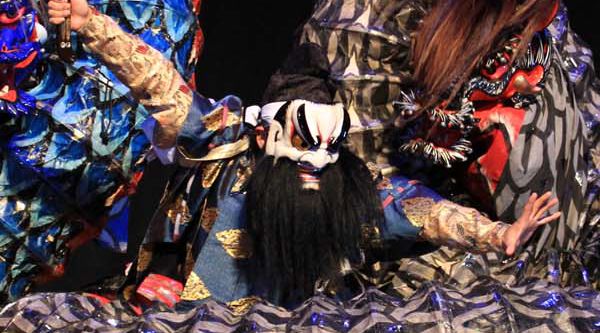
Susano-o-no-Mikoto(Yamata-no-Orochi)
Hime (The Ladies)
Hime refers to all female characters, many of whom turn into demons. Some examples are as follows:
Kushi’inada-hime: appears in the play The Eight-Headed Demon Snake as the next victim of the terrifying demon. She is saved by Susano-o-no-Mikoto.
Satsuki-hime (Lady Takiyasha): The main character in Lady Takiyasha, one of the most popular Geihoku Kagura plays, Satsuki-hime is a woman driven by revenge who eventually turns into a demon.
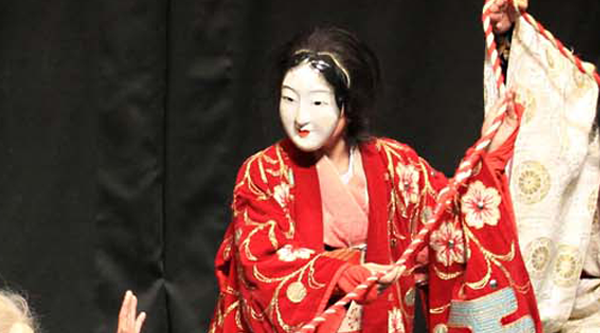
Kushi’inada-hime(Yamata-no-Orochi)
Oni (Demons)
Demons can be either male or female and wear masks of varying shapes and sizes. Some examples include Shuten-dōji, Lady Takiyasha, and Ekijin.
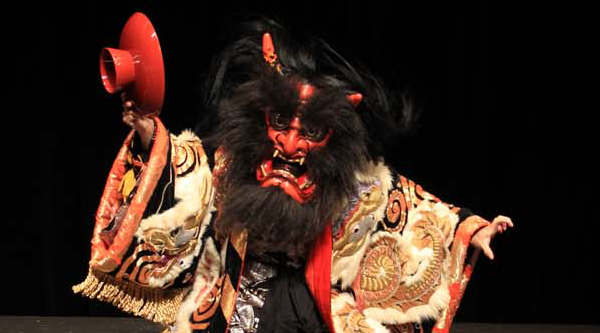
Shuten-dōji(Oyeyama)
Akutō (Bandits and Henchmen)
These bad guys are generally the henchmen to greater demons and typically have long hair.
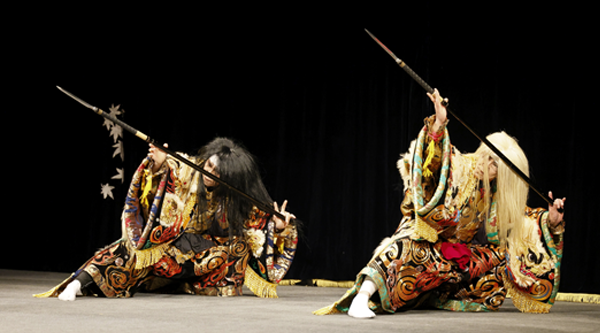
Yasyamaru・Kumomaru(Takiyasha-hime)
Other Characters
There are many more characters that appear depending on the play, including elderly men and women, Ebisu (a well-known god), comic relief characters, mythical foxes, and more.
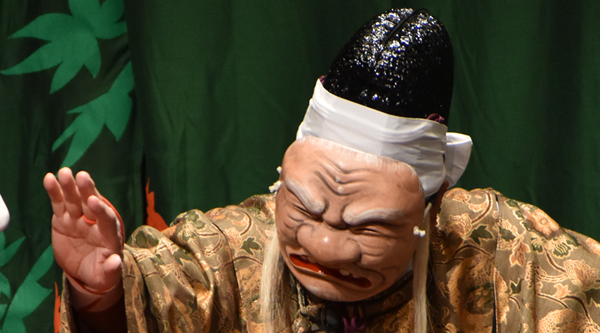
Ashinazuchi(Yamata-no-Orochi)
Play Format
Geihoku Kagura is full of stories where virtue is rewarded and vice is punished, and the format is mainly made up of five scenes: Michi-yuki (Backstory, lit. “The story until now”), Saguri (Demon’s backstory, lit. “Putting feelers out, to suss out”), Karami
(Confrontation), Tachi-ai (Battle), and Ureshi-mai (Victory dance, lit. “Dance of joy”). The language used in kagura plays is a kind of classical Japanese that even Japanese people have a hard time understanding! That’s why it’s helpful to read a summary of the story in advance, so you’ll have an easier time following it.
Backstory (Michi-yuki)
Here, the main character of the story (anyone except the demon: god, warrior, refined lady, clown, villain) makes their first appearance. The main character performs a dance and introduces themselves and why they are here. A classic example is a warrior off to defeat a demon: they first introduce themselves, then explain they are going to a certain place to battle a demon before setting off. In addition, each time a new character appears, they perform michi-yuki to explain their character.
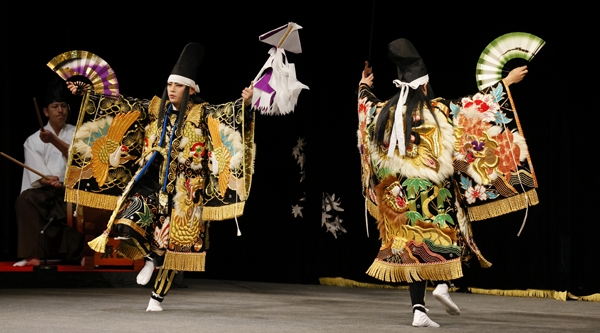
Demon’s Backstory (Saguri)
This is where the demon makes their first appearance. This scene is their version of michi-yuki where the demon performs a dance that expresses their character: threatening, menacing, terrifying. In earlier kagura, the movements were more subtle than modern renditions, which is why it’s called saguri (lit. “putting feelers out, to suss out”).

Confrontation (Karami)
The hero and the demon meet. For example, the demon gets suspicious of the hero who has come to destroy them, or the hero evades the demon. These scenes can include the hero and demon engaging back and forth in conversation as well.
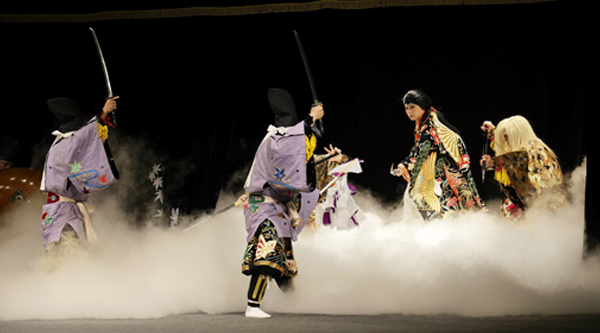
Battle (Tachi-ai)
The hero and demon face off in a dramatic battle. This is the climax of the performance characterized by a fierce and frantic battle. This is also where demons use the full force of their mystical powers.
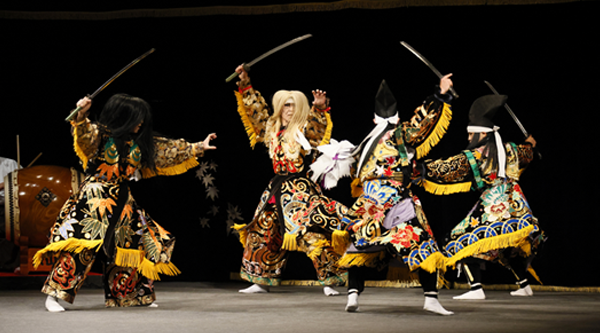
Victory Dance (Ureshi-mai)
The hero performs a dance to express their joy at defeating the demon, ending the play on a joyous note.
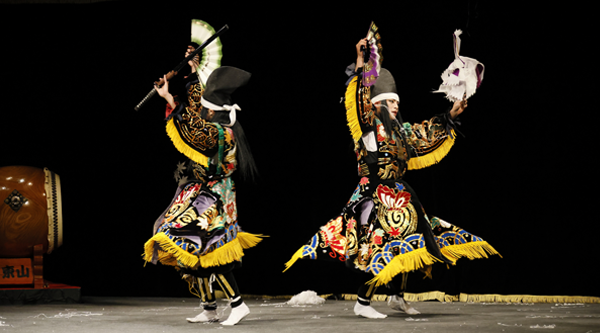
The Music of Kagura
Kagura is accompanied by live music called sōgaku played on four instruments: the kagura flute, hand cymbals, small taiko drum, and large taiko drum. The musicians are called gakunin (lit. “classical musicians”). These musicians play during the performance from start to finish, yet if you look closely, you’ll notice there is no sheet music in front of them! Each musician learns the music by ear, gradually picking up the distinct sound and rhythm of their troupe. Many of the performers’ movements are synchronized with the live musical accompaniment, adding to the excitement of the performance.
In addition to playing music, the musicians (mainly the large taiko drummer) also sing. The songs can range from waka poetry that set the scene, to expressing gratitude to the gods, such as those sung during the victory dance portion of the play.
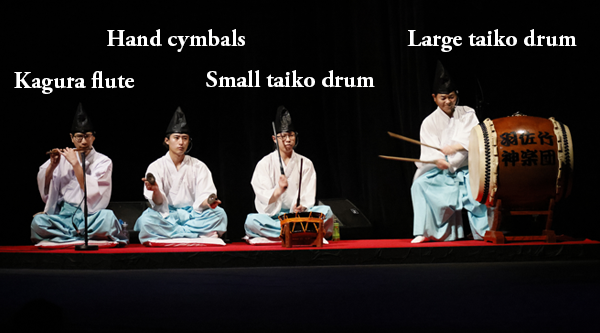
Decorations and Props
Tengai (Canopy)
The canopy (tengai) is a frame suspended above the kagura stage with colorful folded paper hanging down. It serves as a way for those in this world to communicate with the gods, and acts as a barrier to ward the stage below against evil spirits. The different colored paper, patterns, and positions also have their own meanings.
Green: represents spring and the cardinal direction east
Red: represents summer and the cardinal direction south
White: represents fall and the cardinal direction west
Black: represents winter and the cardinal direction north
Yellow: represents the four doyō, a period of 18 days before the first day of spring, summer, fall, and winter, according to the traditional lunisolar calendar
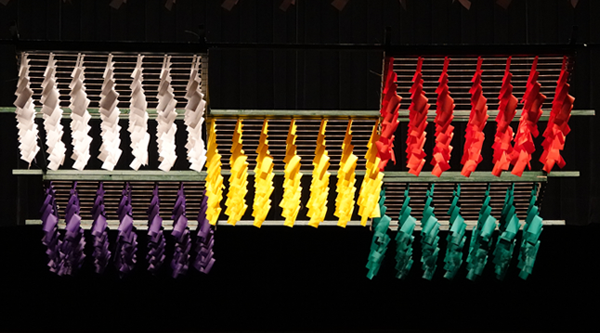
Temono (Props)
In addition to the swords and fans that many characters hold, the go-hei (wooden wands decorated with sacred paper streamers) that the heroes hold represent the protection and power of the gods. The demons, on the other hand, usually hold oni-bō (staff with puffs of thinner paper streamers attached at the top and bottom).
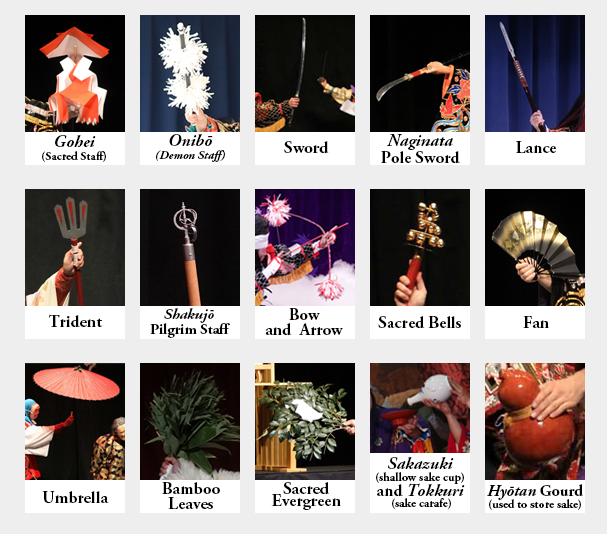
Men (Masks)
Most kagura plays will have at least one character wearing a mask. It is said that when performers don a kagura mask, they take on the spirit of the mask, whether demon or god. Thus, masks play an important role in kagura as a ritual.
Each mask is handmade by a mask artisan. First, a clay mold is made. Then, durable Sekishū washi paper is layered onto the mold. Once it dries, the clay mold is removed, and the paper mask is painted.
Creating the facial expression is the most difficult part of the painting process. especially when it comes to demon masks: you can see how talented mask artisans are when looking at the terrifying expressions and faces they create.
There are many different kinds of masks used in performances, with the bigger ones weighing about 300 grams. These kinds of masks can take about six months to create and cost a whopping 400,000 yen! Each troupe carefully passes down these handmade craft works, preserving the artistry and the spirit that resides within.

Costumes
One of the biggest features of Geihoku Kagura is the elaborate costumes. These ornate creations differ depending on the character with different designs and motifs. More extravagant costumes make use of fabrics such as gold brocade, satin, and black velvet hand-embroidered with gold and silver threads. In addition, silver and gold-plated shiny copper plates and glittering glass beads may also be added.
For larger costumes like the ones that demons wear, it can take up to six months to complete a new one and costs, on average, about 1.5 million yen. A heavy price to pay for an equally heavy costume, weighing in at 15 kilograms.
Many of the costumes used in performances are made possible by donations from the local community and kagura troupe members from years gone by. Over the years, these costumes are lovingly cared for and repaired so that they can be worn by future generations. Some troupes even have costumes that have been worn for over 50 years!
